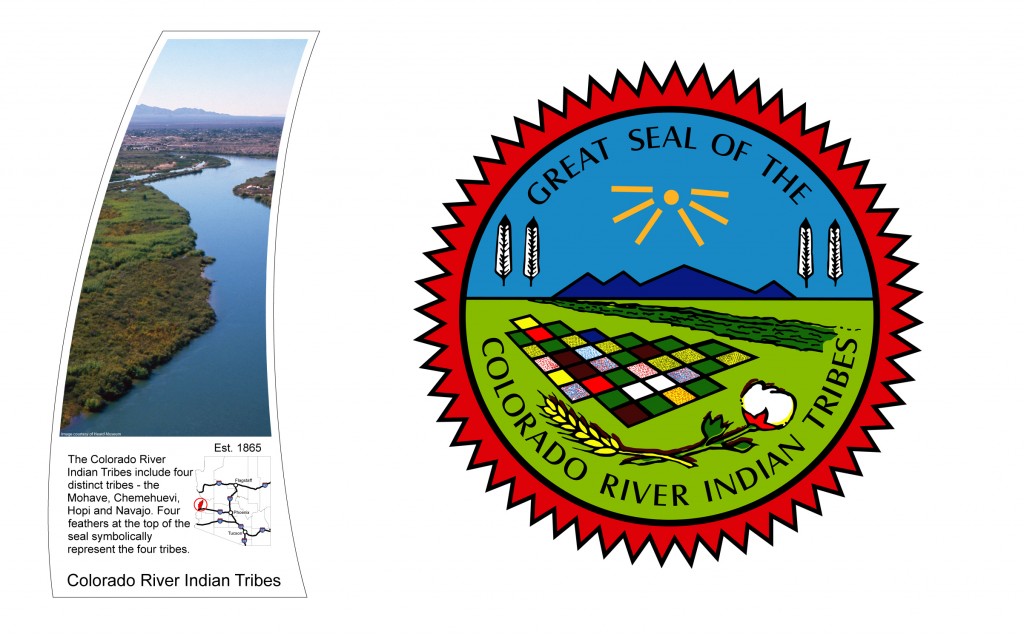
The Colorado River Indian Reservation. Source http://www.parkerareatourism.com/community/recreation/reservation.htm
Reservation
The Colorado River Indian Tribes (“CRIT”) consist of four tribes: Mohave, Chemehuevi, Hopi, and Navajo. In 1865, the federal government set aside approximately 300,000 acres as a reservation for the “Indians of the Colorado River and its tributaries”.[1] The reservation is located in southwestern Arizona and southern California, where it is divided by 48 miles of the Colorado River.
Population
There are an estimated 4,000 persons constituting the four tribes of CRIT.[2]
Water Resources
Settlement
Arizona v. California (1963) established water use rights of the Colorado River for CRIT, as well as the Cocopah Indian Tribe, Chemehuevi Tribe, Fort Mojave Indian Reservation, and Fort Yuma Indian Reservation.[3]
Quantity
Pursuant to Arizona v. California, CRIT is entitled to divert 719,248 acre-feet annually (“afa”) or “the quantity of mainstream water necessary to supply the consumptive uses required for irrigation of 107,903 acres and for the satisfaction of related uses, whichever . . . is less.”[4]
Source of water
The Colorado River is the source of CRIT’s diversion rights from within both Arizona and California.[5] CRIT is involved with a number of different tribal organizations seeking to create an influential voice in the management of the Colorado River. CRIT is a part of the Colorado River Basin Tribes Partnership.
CRIT’s economy is based on agricultural activity and the primary use of the water on-reservation is for irrigation.[6] The water decreed in Arizona v. California has permitted CRIT to develop a vibrant farming community. An aqueduct cuts across the CRIT reservation, delivering water to the various irrigation systems. CRIT uses “99.7%” of their entitlement to irrigate crops on the reservation. Of the over 600,000 af applied for farming, there is approximately 300,000 af of return flow.
Water Marketing
CRIT has considered marketing the only portion of its water right that CRIT is not completely utilizing: the return flow. Even with discussion of potential marketing efforts, CRIT would “never market its water entitlement” used for farming, but would love to market its return flow or unused portion of water. “It’s a cultural and practical thing. CRIT Farms employs many people. CRIT would feel like they were selling their souls if they sold their water right.” The farm is at the core of the local community. The Colorado River Irrigation Project (CRIP) is the largest Bureau of Indian Affairs irrigation District in the entire United States.[7]
[1] About the Mohave, Chemehuevi, Hopi, and Navajo Tribes, Colorado River Indian Tribes, http://www.crit-nsn.gov/crit_contents/about/ (last visited Apr. 19, 2013).
[2] About the Mohave, Chemehuevi, Hopi, and Navajo Tribes, supra note 1.
[3] Id.
[4] Arizona v. California, 547 U.S. 150, 126 S. Ct. 1543, 164 L. Ed. 2d 271, 2006 U.S. Lexis 2703 (2006).
[5] Regional Conservation Committees: Colorado River Report, Sierra Club, http://www.sierraclub.org/rcc/southwest/coreport/background.asp#Central%20Arizona%20Project%20(CAP) (last visited June 25, 2013).
[6] Colorado River Indian Tribes, Inter Tribal Council of Arizona, Inc., http://itcaonline.com/?page_id=1152 (last visited Apr. 19, 2013).
Contact:
26600 Mohave Road
Parker, AZ 85344
Phone: (928) 669-9211
feedback@critonline.com
If you would like to learn more about the this tribe, click here to go to their website.
